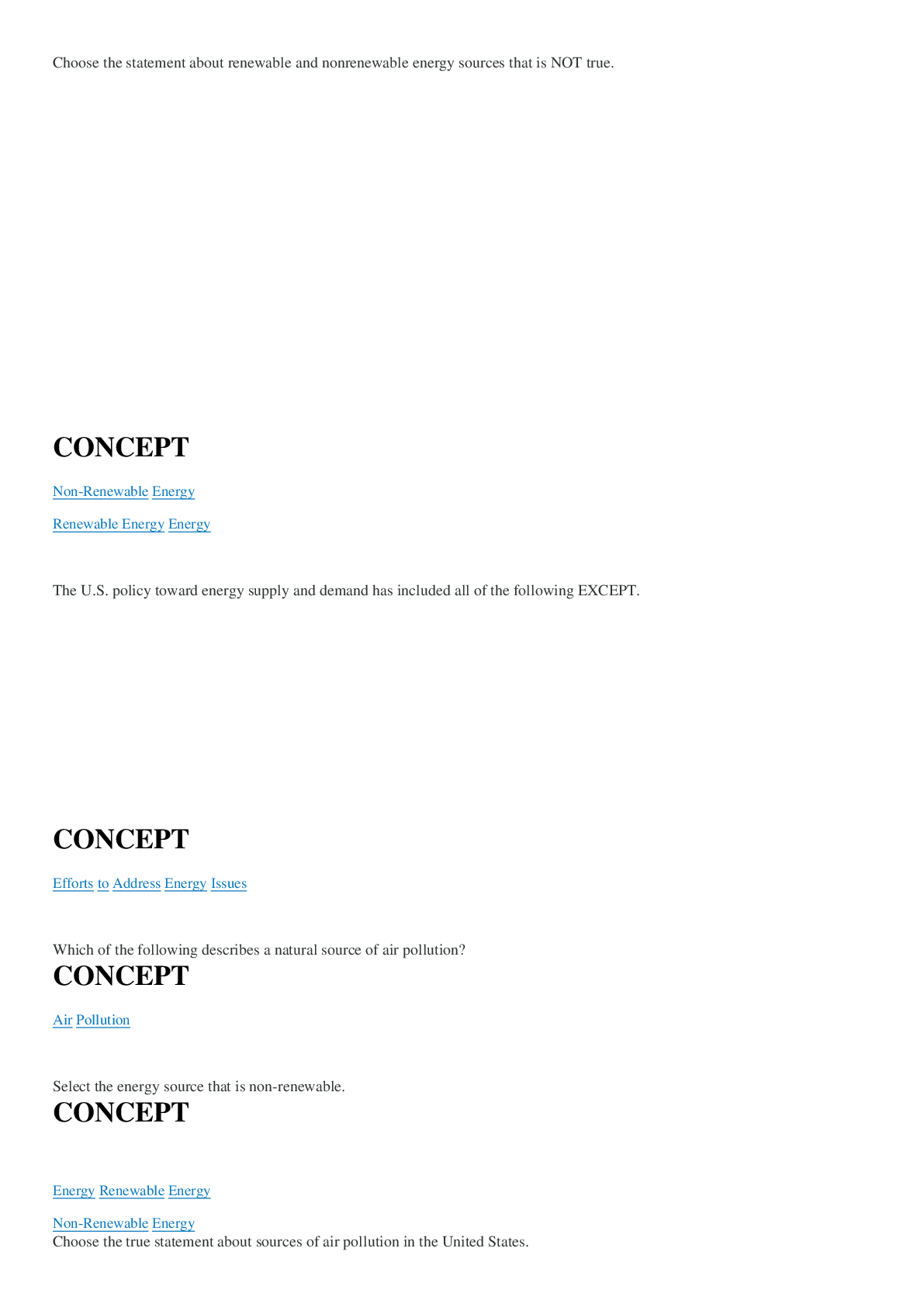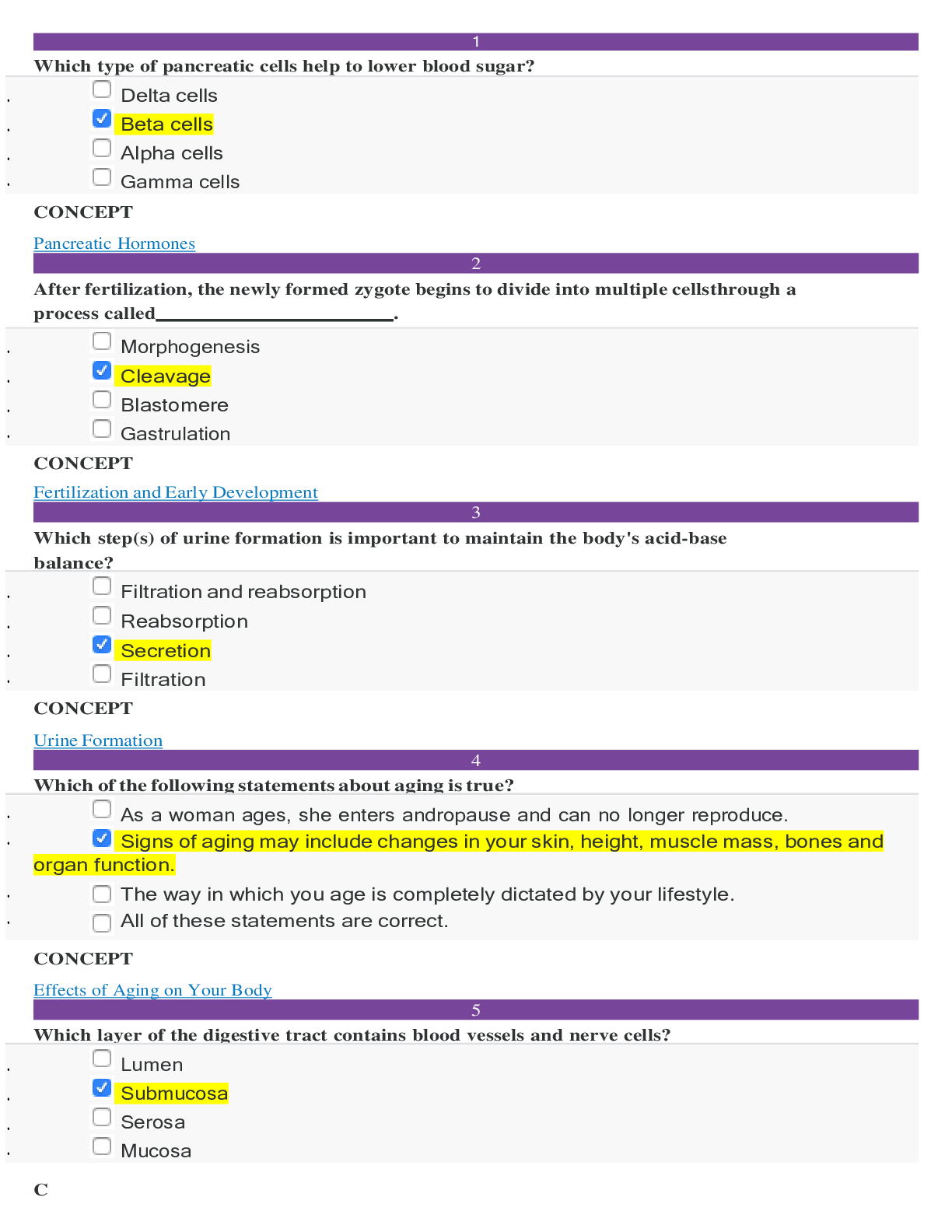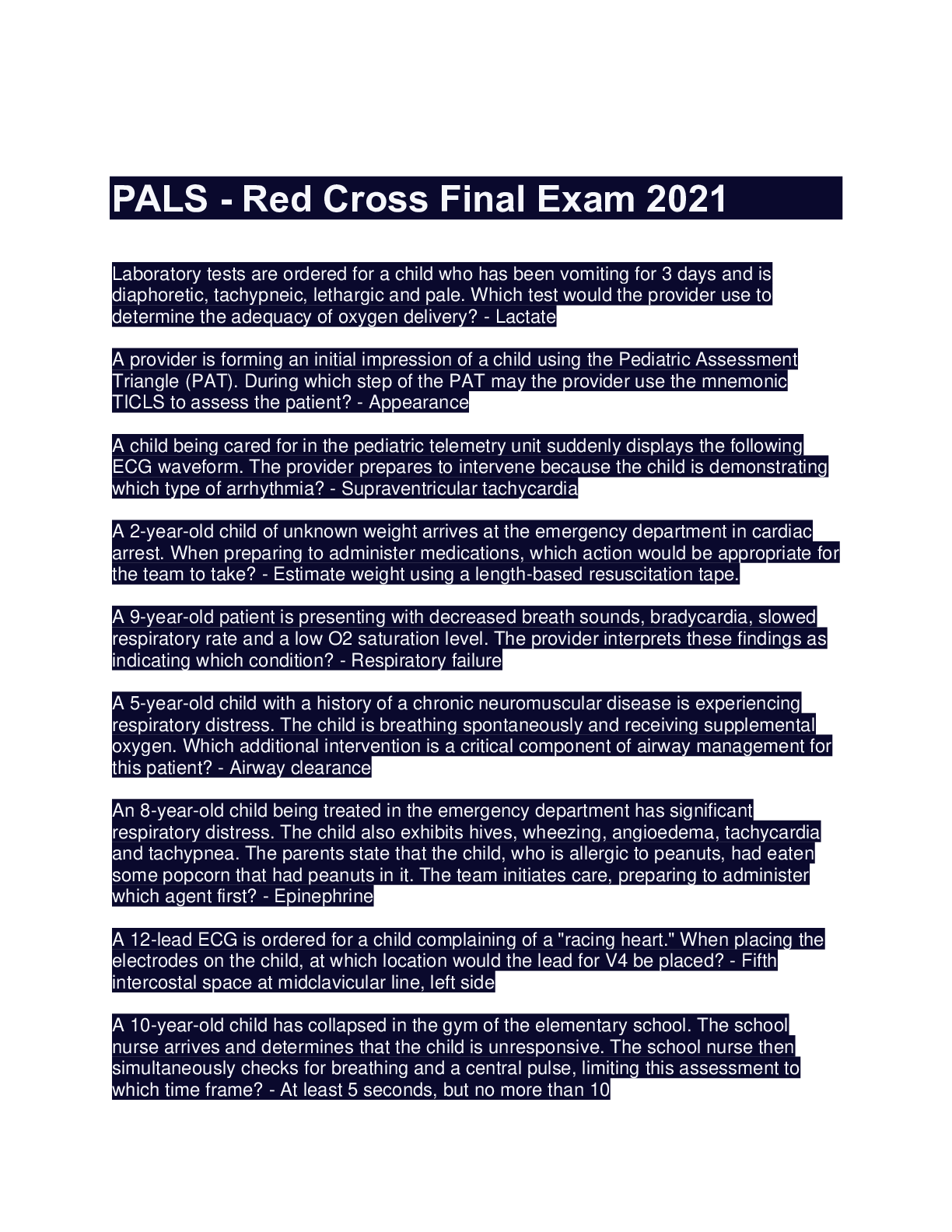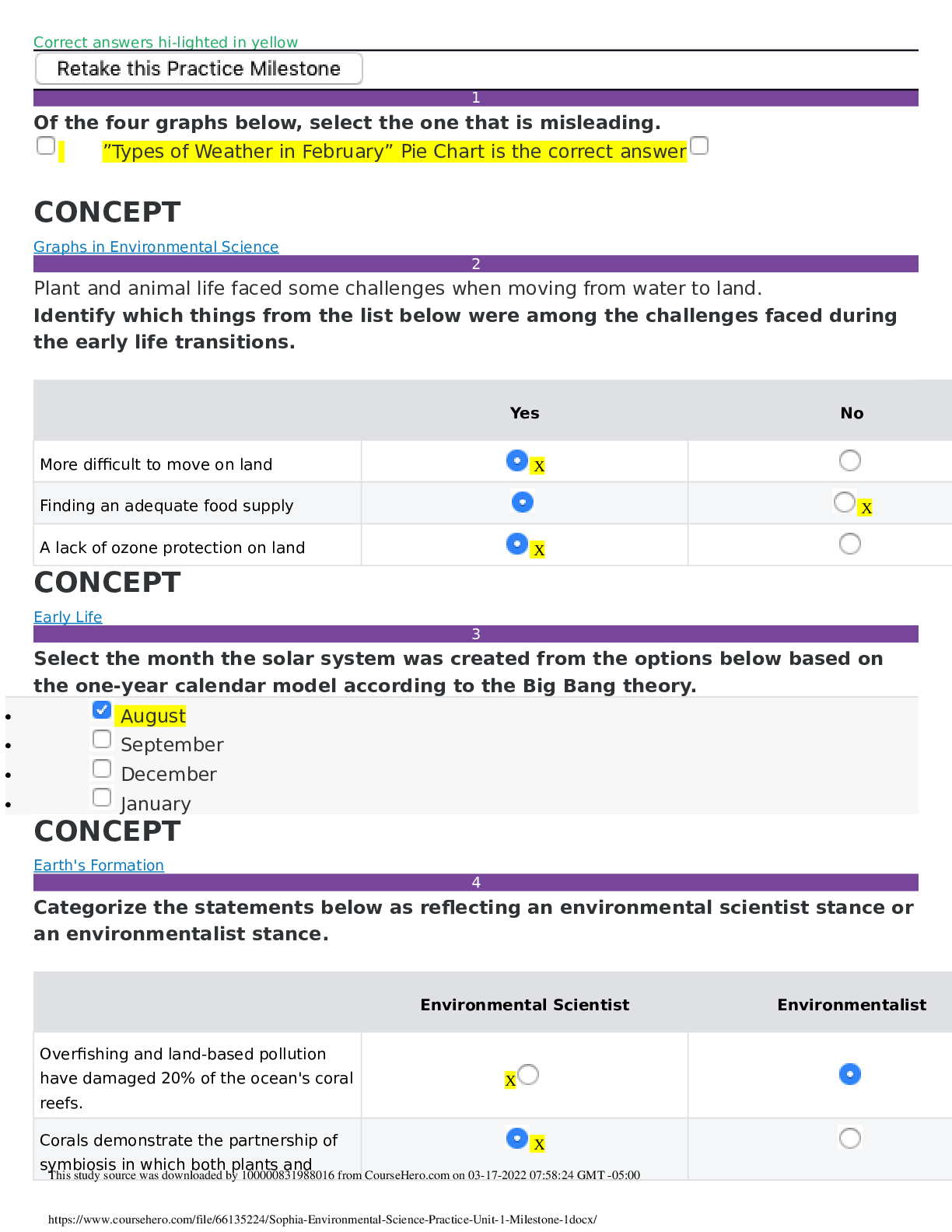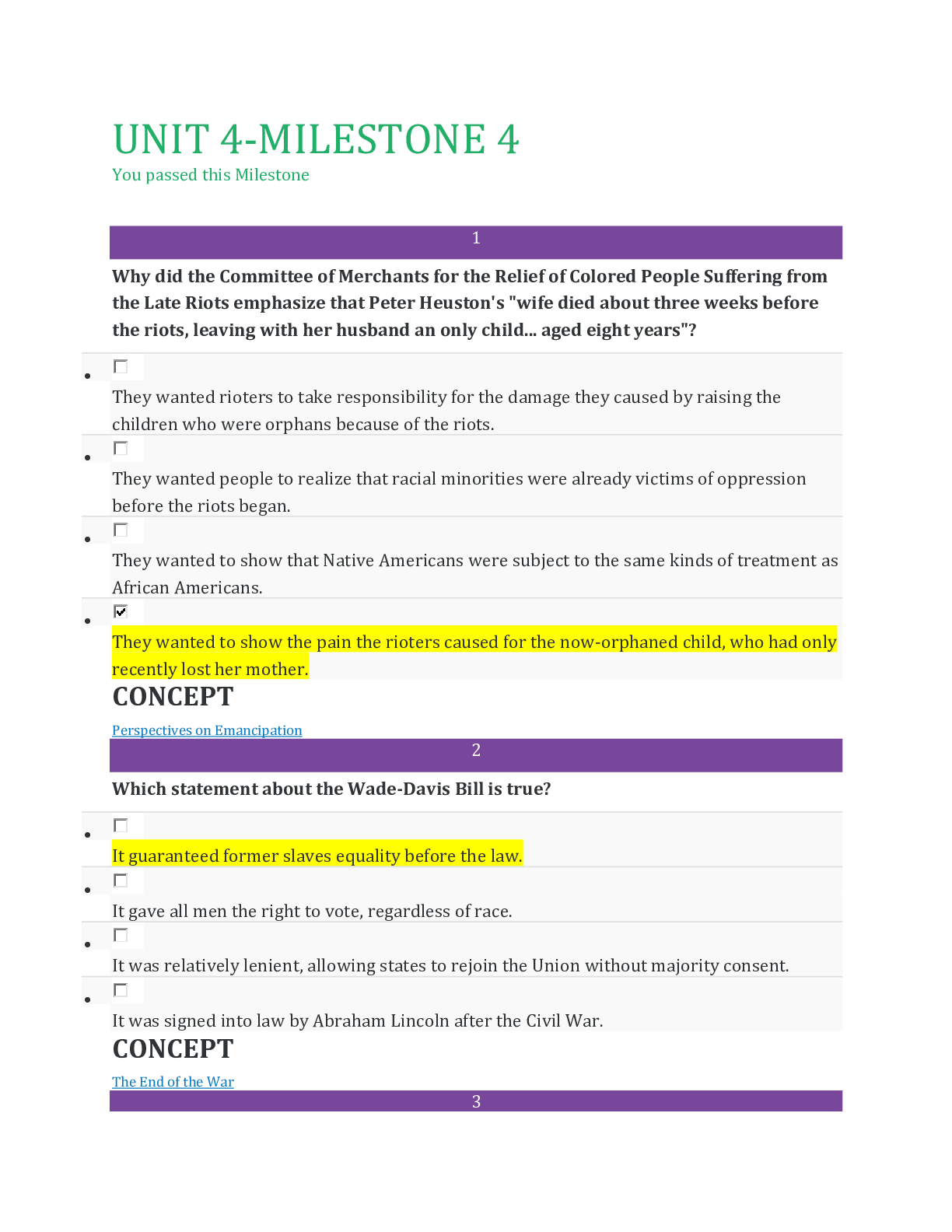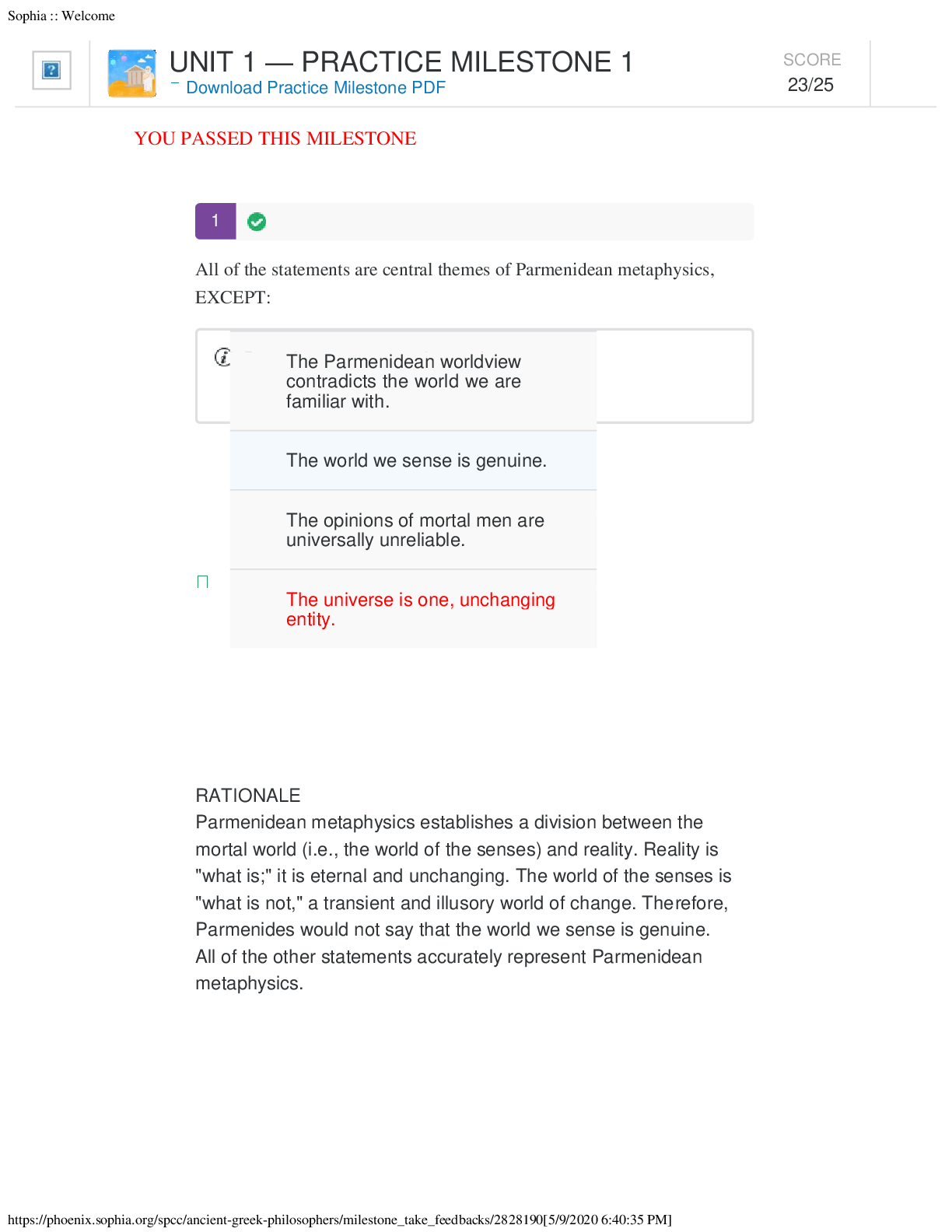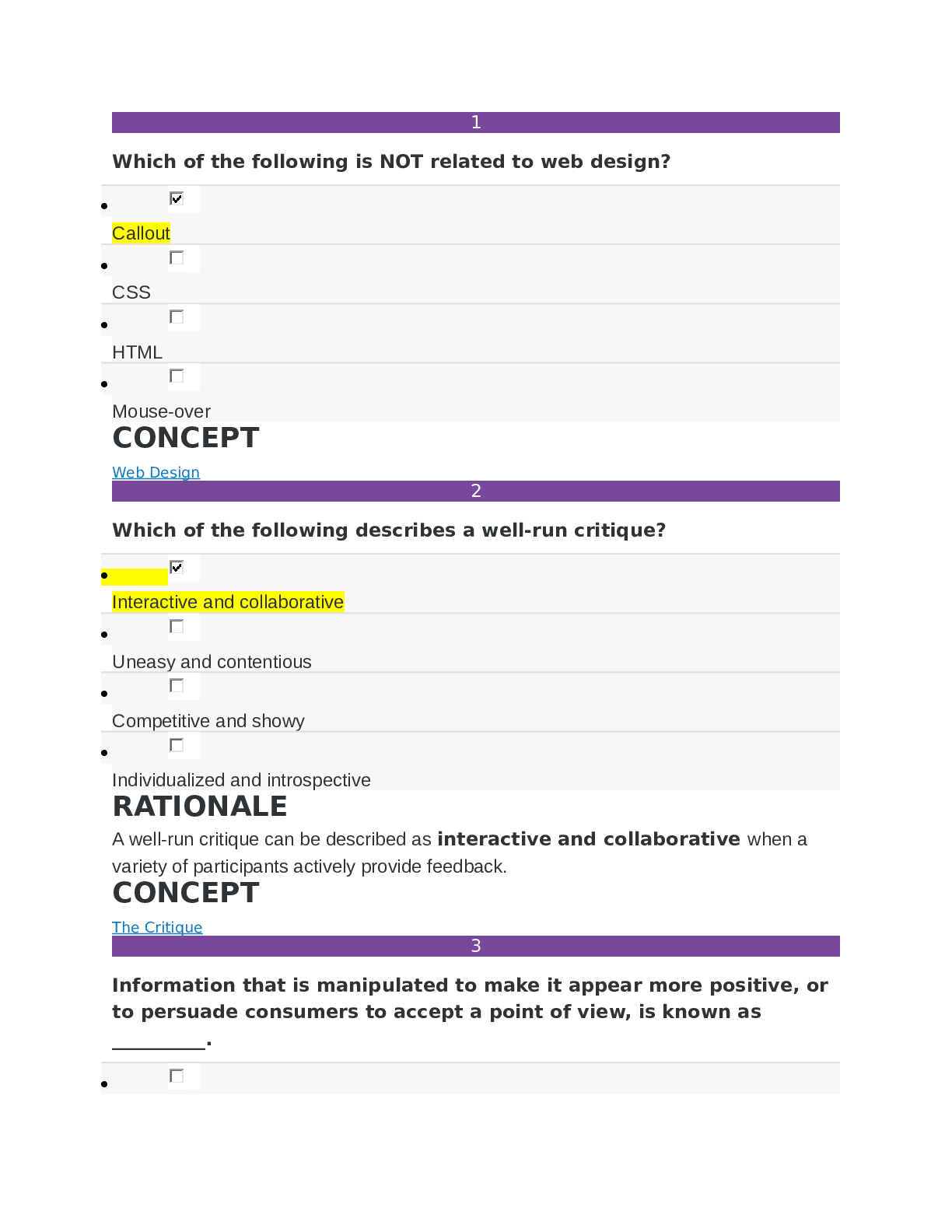Statistics > SOPHIA PATHWAY > MATH 1280 Practice Milestone UNIT 1 Introduction to Statistics (2020) – University of the People | (All)
MATH 1280 Practice Milestone UNIT 1 Introduction to Statistics (2020) – University of the People | MATH1280 Practice Milestone UNIT 1 Introduction to Statistics (2020)
Document Content and Description Below
1 MATH 1280 Practice Milestone UNIT 1 Introduction to Statistics (2020) – University of the People Which of the following data types will be continuous? • Number of cars produced by a c... ar company in a year • Number of skyscrapers in a city • Number of correct answers on a ten-question true/false test • Weight of a baby whale RATIONALE For data to be continuous, it means it can take on any value inside of an interval. Since the weight of a baby whale can take on any numerical value inside of possible ranges of weights, it is continuous. CONCEPT Discrete vs. Continuous Data 2 Which of the following correctly identifies a sample with non-response bias? • A person becomes ashamed to answer a question regarding his or her past drug use • The wording of a question about politics causes the subject to misinterpret the meaning of the question • A person selected to be a part of the survey is unable to be contacted or refuses to participate • A telephone poll excludes individuals who do not have phones RATIONALE Non-response bias is simply when someone can't respond or refuses to do so. CONCEPT Nonresponse and Response Bias 3 One typical way to select a sample is to randomly pick phone numbers from a telephone book. Which of the following explains how the selection of the sample could be biased? • The sample does not represent those that cannot afford a telephone. • All of these choices would introduce a bias. • The sample does not represent those that chose not to have a telephone. • The sample does not represent those do not list their phone numbers. RATIONALE By choosing to use a telephone number, they would be excluding anyone who might not use a phone, doesn't want their number public, etc. By excluding these types of people, they would not capture all people in the population and if these groups would respond differently in a study, the study would be biased. CONCEPT Bias 4 Max conducted a clinical trial for a new vitamin supplement. He had two groups in his clinical trial. The control group was given a sugar pill, and the treatment group was given the new vitamin supplement. However, many of the participants in the control group reported improvements in their general health, similar to the treatment group. The ________ may describe the reason some participants from the control group reported health improvements. • response variable • placebo effect • confounding variable • treatment group RATIONALE When people in a control group indicate that there is some noticeable change, in this case an improvement in health, this is an example of what we call a placebo effect. CONCEPT Placebo 5 In a survey of a large high school class, responses to which two of the following questions will be qualitative? • What is your height in inches? • Are you male or female? • Are you right-handed or left-handed? • How many minutes do you spend working on homework on a typical weeknight? RATIONALE Qualitative simply describes things and can't be represented with numbers which can then be used in arithmetic. Gender simply describes someone. CONCEPT Qualitative and Quantitative Data 6 Which of the following describes cluster sampling? • Choose a sample in such a way that every nth person or item is included. • Choose a sample so that every member of the population has an equal chance of being selected for the sample. • First divide the population into groups, and then randomly pick individuals from each group, so that the sample is proportionate to the population. • Divide the population into groups, and then randomly select some groups. Choose all the members within the selected groups to be part of the sample. RATIONALE Cluster sampling is when the population is broken up into clusters, which are generally based on something like geography. You then randomly choose groups or clusters and members of those clusters are included in the sample. CONCEPT Stratified Random and Cluster Sampling 7 A sample composed of people who are readily available or easily recruited is called a __________ sample. • random • convenience • cluster • self-selected RATIONALE When you choose a sample based on how easy it is to gather the data, this is referred to as a convenience sample. CONCEPT Convenience & Self-Selected Samples 8 A professional quarterback completed 66% of his passes in 2008 and 68% of his passes in 2009. Of the following choices, which of the following TWO are correct about the quarterback’s completion rate? • It rose by 3%. • It rose by two percentage points. • It rose by 2%. • It rose by three percentage points. RATIONALE We can note that the absolute difference between 2008 and 2009 is 66% to 68% or 2 percentage points. To get the percent difference we take the absolute difference and divide by the initial value: So we can say the quarterback's completion rate rose by 3%. CONCEPT Using Percentages in Statistics 9 At a school of 1,500 students, 20% are left-handed. A student randomly selects 200 students and obtains 22% left-handed students. A second student takes another random sample of 250 students and obtains 27% left-handed students. Which of the following should the difference between the percentages be attributed to? • The sample sizes were both too small, which is why they both obtained figures different than 20%. • Random error; the numbers were different due to variability inherent in sampling. • Both samples suffered from non-response bias. • The samples were not random samples. RATIONALE When sampling from the population, even when you gather a random sample, there is not a guarantee it will exactly equal the true population value. So, even in this case where the sample values are not exactly equal to 20%, since the samples are randomly drawn, this is probably simply due to the variability that occurs when sampling. This is simply random error. CONCEPT Random and Systematic Errors 10 The following shows the Consumer Price Index (CPI) for the years 2000-2005. All of the values use a reference year of 1983. Which of the following is true about the CPI, based on the information? • $100 in 2000 would be equivalent to $178 in 2001. • $100 in 2004 would be equivalent to $189.70 in 1983. • $100 in 1983 would be equivalent to $194.50 in 2005. • The CPI does not change very much from year to year. RATIONALE Recall that the CPI is a way to adjust for price level changes from year to year. The base value for the CPI is 100 and all values are in reference to that value. Each CPI value for a corresponding year tells us what the value of $100 in the base year is in the corresponding year. So, the value of $100 in 1983 is equivalent to having $194.50 in 2005. CONCEPT Index Number and Reference Value 11 The type of experimental design that first divides participants into homogeneous groups before randomly assigning treatments and controls is called a(n) __________. • matched-pair design • randomized block design • multi-stage sampling • completely randomized design RATIONALE When we first break up items into block and then assign treatment, this is called a randomized block design. CONCEPT Randomized Block Design 12 Which of the following definitions corresponds with an observational study? • Controlling the environment and observing the response • Measuring variables of interest but not attempting to influence responses • Selecting a sample from the population of all individuals about which information is desired • Doing something intentionally to the individuals involved RATIONALE An observational study is one in which the researcher doesn't try and control for the setting. They simply gather data on the variables in the study. An experiment is when the researcher intentionally or actively controls for the setting in which the study takes place. CONCEPT Observational Studies and Experiments 13 A poll was conducted two weeks before an election and showed that the incumbent would win with 56% of the vote and a margin of error of 4%. If the incumbent needs to receive at least half the votes to win the election, can there be confidence in the incumbent’s victory? • Yes, because the lowest the incumbent could receive is 52% of the vote. • Yes, because the poll stated that the incumbent will win with 60% of the vote. • No, because she could receive as low as 4% of the vote. • None of the above RATIONALE Recall for a confidence interval, we take the point estimate +/- margin of error. Using this framework we take the point estimate of 56%, then add and subtract the margin of error, 4%. This gives us a CI of 52% to 56%. Since the lower value is greater than 50%, we are confident that the incumbent should earn at last 50% of the votes and win the election. CONCEPT Margin of Error 14 Jenae also noticed that some of the coffee labels were much more visually attractive than others. She replaced the original coffee labels with plain white ones that had the flavor printed in bold black letters, and she placed them on the coffee pots for a week-long experiment. Which of the following statements about Jenae's actions is FALSE? • By ensuring that the labels look the same, Jenae is controlling the "visual appearance" variable. • Because all of her labels are the same, Jenae could replicate her experiment for other companies. • By making sure that the labels all look the same, Jenae is ignoring randomization in her experiment. RATIONALE This is a description of an experiment. Jenae is controlling for things by using the same labels. This allows for replication in other settings. By doing this, randomization is not compromised. CONCEPT Experimental Design 15 Julie wanted to find out the approximate percentage of non-traditional female college students at public universities. She decided to randomly select 25 females from each university in her state and collect and analyze the data. Select the statement that is TRUE. • The female college students at state universities are the sample, and the female college students at all universities in the United States are the population. • All female college students at state universities are the sample, and the 25 females that Julie interviews are the population. • The 25 females that Julie interviews are the sample, and all female college students at state universities are the population. • The 25 females that Julie interviews are the sample, and the females that Julie does not interview are the population. RATIONALE The population is the entire set of interest and the sample is a subset of that larger group. In this case the 25 sampled women are the sample and the entire set of interest is all females at all public colleges or universities in her state. CONCEPT Sampling 16 A binomial question is __________ an open question. A closed question is __________ a binomial question. • always; sometimes • always; never • never; always • never; sometimes RATIONALE A binomial has only two responses. Since there are only two responses that can occur, it is by definition a closed question and is not considered an open question. Closed questions don't need to only have two responses. So, only closed questions with two responses are binomial, but they could have more than two responses. CONCEPT Question Types 17 Which of these statements is true about a blind experiment? • The total population is divided into homogeneous blocks. • Some people involved are prevented from knowing certain information that might lead to biased results. • Closely matched elements are paired and then treatments are allotted to them. • The total population is divided roughly into some groups and then some of the groups are randomly selected. RATIONALE Blinding helps to prevent members of a study know key information in order to prevent them from behaving or responding in a fashion that would be biased if they knew if they were in a treatment or control group. For example, if you knew you were in a treatment group, you might be more inclined to say it is working or give responses that indicate that it is. CONCEPT Blinding 18 Which of the following describes simple random sampling? • Choose a sample in such a way that every nth person or item is included. • Choose a sample so that every member of the population has an equal chance of being selected for the sample. • First divide the population into groups, and then randomly pick individuals from each group, so that the sample is proportionate to the population. • Divide the population into groups, and then randomly select some groups. Choose all the members within the selected groups to be part of the sample. RATIONALE The definition of a simple random sample means that every item in the sample can be chosen with equal probability. CONCEPT Simple Random and Systematic Random Sampling 19 The type of experimental design where the assignment of experimental units to treatment and control groups is random is called a(n) __________. • matched-pair design • multi-stage sampling • completely randomized design • randomized block design RATIONALE When each element of a sample has an equal chance of being put into a treatment or control group without considering any other factors, this is called a completely randomized design. So each element in the sample has an equal chance of being put into treatment or control. CONCEPT Completely Randomized Design 20 In a study to assess the risk of lung cancer with the number of cigarettes smoked per week, researchers randomly selected subjects who smoked, collecting data on the number of cigarettes they smoked per week, and made note of which subjects developed lung cancer. This is a(n) _________ statistical study. • prospective • retrospective • experimental • survey RATIONALE Since they measured the number of cigarettes moving forward, this is called a prospective study. CONCEPT Prospective and Retrospective Studies 21 Which of these random samples qualifies as a representative sample to find out what parents think about the levels of college tuition fees in the state? • 50 parents of college students from the state • 50 residents of a county in the state • 50 residents of a city in the state • 50 parents of school students from another state RATIONALE For a sample to be representative it should look like and be drawn from the population of interest. In order to understand how parents in the state think about tuition, they should draw upon parents in the state who have children in college. CONCEPT Random & Probability Sampling 22 The type of experimental design that groups experimental units based on similar characteristics is called a(n) _________. • matched-pair design • randomized block design • multi-stage sampling • completely randomized design RATIONALE When you try and control for certain characteristics that might influence your findings in a study by matching observations in pairs on those characteristics, it is an example of matched-pair design. CONCEPT Matched-Pair Design 23 Consider the following dart board and darts. Using the words “accuracy” and “precision,” how would the arrangement of darts be best classified if the thrower was aiming for the bullseye in the center? • High accuracy and high precision • High accuracy and low precision • Low accuracy and low precision • Low accuracy and high precision RATIONALE Accuracy refers to how well something performs. The darts are not near the center, so they are not very accurate. Precision refers to how tightly packed the measures are. Since the measures are close to one another, they are very precise. CONCEPT Accuracy and Precision in Measurements 24 Data that was gathered for a past study and re-used to answer questions in a present study is called __________ data. • biased • raw • confounding • available RATIONALE Available data has already been collected. Since the data was gathered for a past study, it is an available or existing dataset. CONCEPT Data 25 In the 2008 presidential primary, nearly every poll showed that Barack Obama would win New Hampshire. The polls used random-digit dialers to call a random sample of New Hampshire households. However, many college students came out in support of Hillary Clinton, who ended up winning the primary. Which of the following types of bias affected the conclusions the polls drew? • Response bias • Deliberate bias • Non-response bias • Selection bias RATIONALE Selection bias refers to a mechanism where selection of the sample produces a sample that is not representative. The use of random digit dialers will not capture people with private numbers, don't have a phone, etc. So, using this selection mechanism might produce a selection bias for the sample. CONCEPT Selection and Deliberate Bias 26 In measuring the mass of a 50-gram weight in a science class, some students use a poorly calibrated balance and obtain a value of 55.5 grams. The relative error in their calculation is ________. • -11% • 9.9% • 11% • -9.9% RATIONALE Recall that the percent error is equivalent to the absolute difference divided by the actual value. If the absolute measure is 50 grams and the observed measure is 55.5 grams, then the absolute error is: So we calculate the percentage error to be: CONCEPT Absolute Change and Relative Change 27 The owner of an ice cream shop would like to determine statistically which age groups (<13, 13-21, 22-35, 36-50, and >50) in his city prefer which flavors of ice cream, in order to figure out how to stock the freezer cases at her store. Which of the following would be the most appropriate study to obtain this information? • Experiment • Observational study • None of the above • Census • Survey RATIONALE A survey would allow the owner to quickly gather information on customers and then relate that back to the type of ice cream flavors they like. CONCEPT Surveys 28 In experiments, a(n) _________ variable is controlled to explain a cause and effect relationship. • dependent • explanatory • response • confounding RATIONALE When trying to understand how one variable affects another, the variable that influences the outcome or response variable is called an explanatory variable. So changing the explanatory variable helps us understand the response variable. CONCEPT Variables 29 A survey was conducted to find the number of hours that people spend on their phones in a day. A group of 300 people in a shopping mall were asked about how long they spend on their phone and It was found that 42 people spend at least two hours on their phone in a day. Which of these does not represent inferential statistics? • 14% of the people surveyed in the shopping mall spend at least two hours on their phone in a day. • 14% of the people who live in the county spend at least two hours on their phone in a day. • 14% of the people who visited the shopping mall spend at least two hours on their phone in a day. • 14% of the people who live in the city spend at least two hours on their phone in a day. RATIONALE Recall that an inference is when you take a sample, which is the data at-hand, and make a larger conclusion about a group at-large. Simply stating 14% of the people in the survey spend at least two hours on their phone doesn't draw a larger conclusion. It simply describes what you found in the sample. So it is a descriptive statistic. CONCEPT Statistics Overview [Show More]
Last updated: 1 year ago
Preview 1 out of 22 pages
 – University of the People.png)
Reviews( 0 )
Document information
Connected school, study & course
About the document
Uploaded On
Sep 14, 2020
Number of pages
22
Written in
Additional information
This document has been written for:
Uploaded
Sep 14, 2020
Downloads
0
Views
145


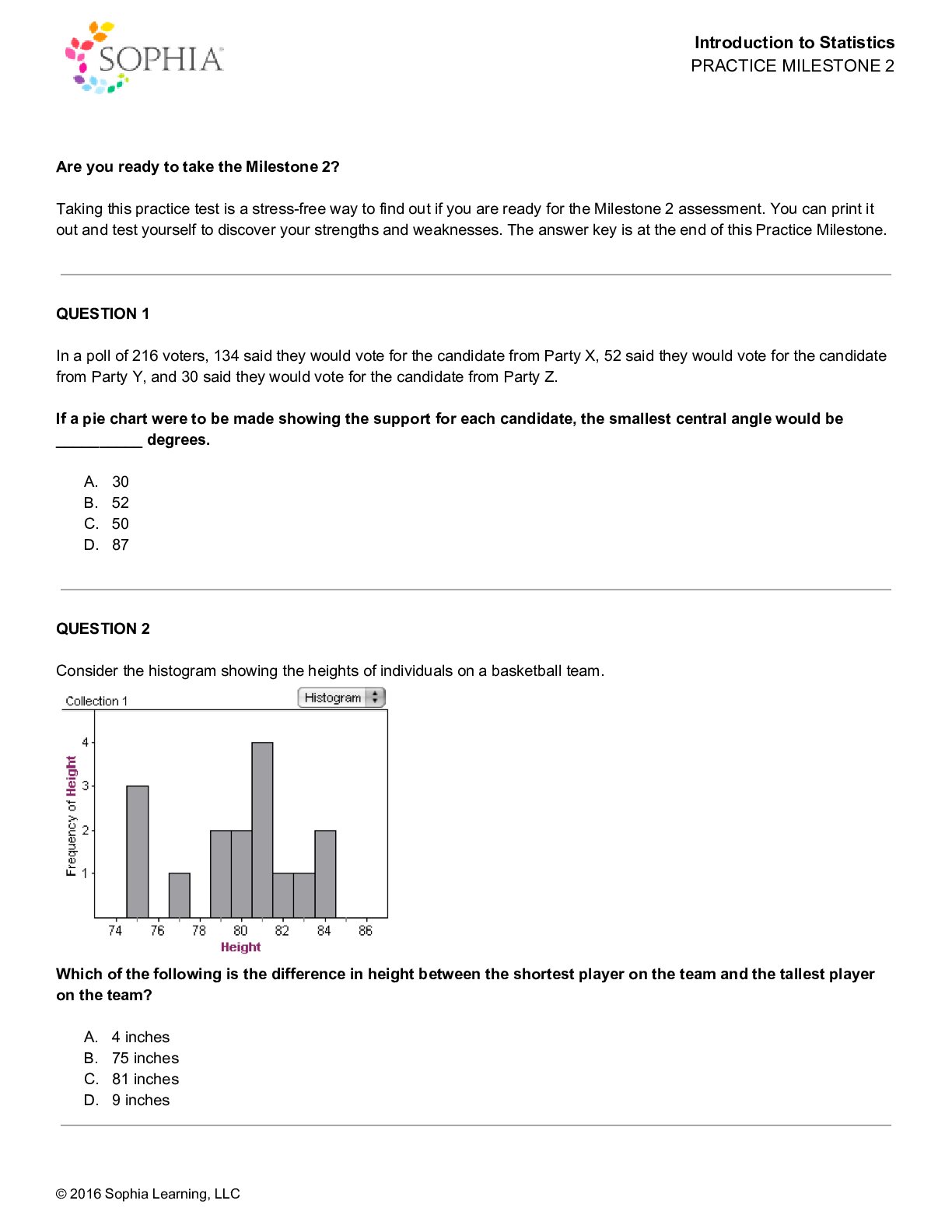
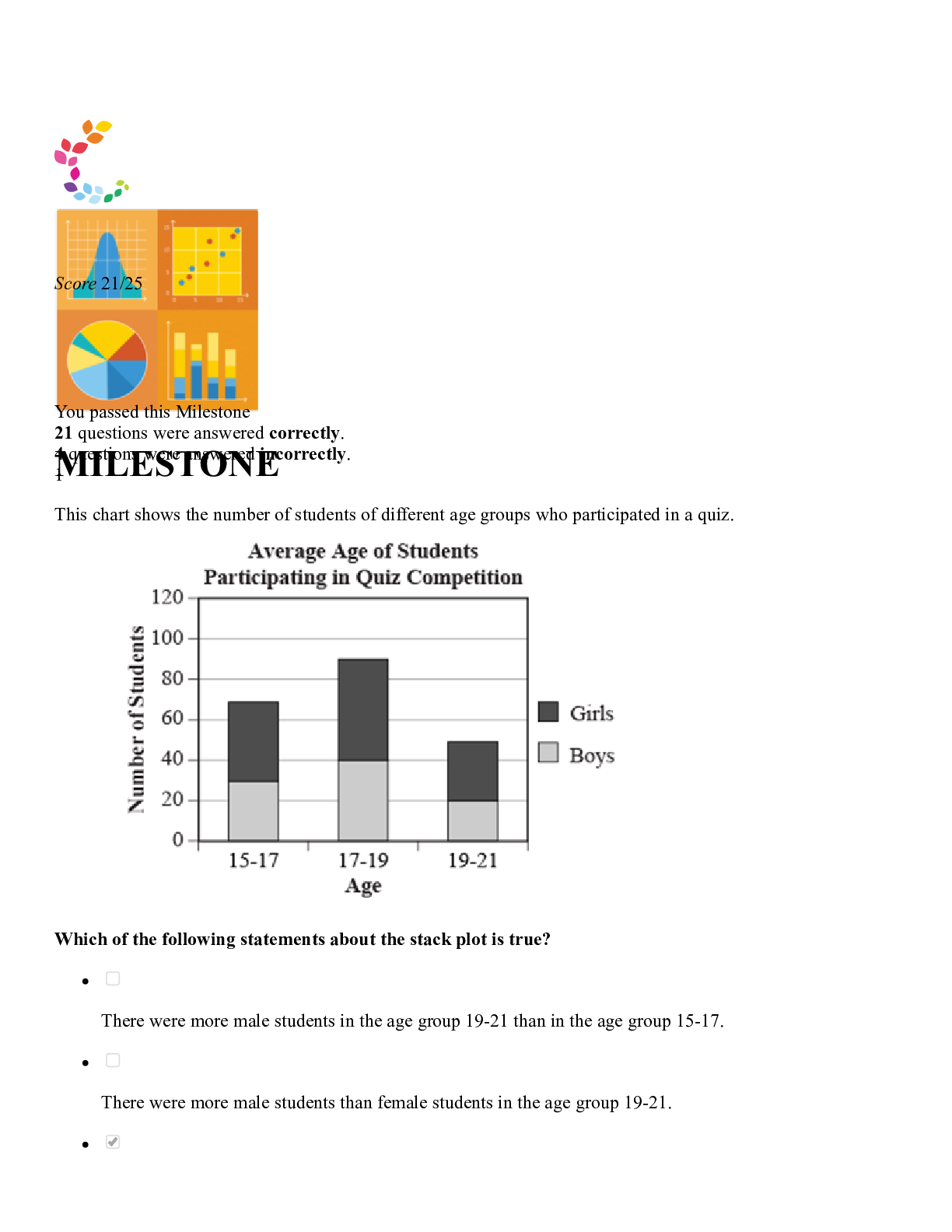

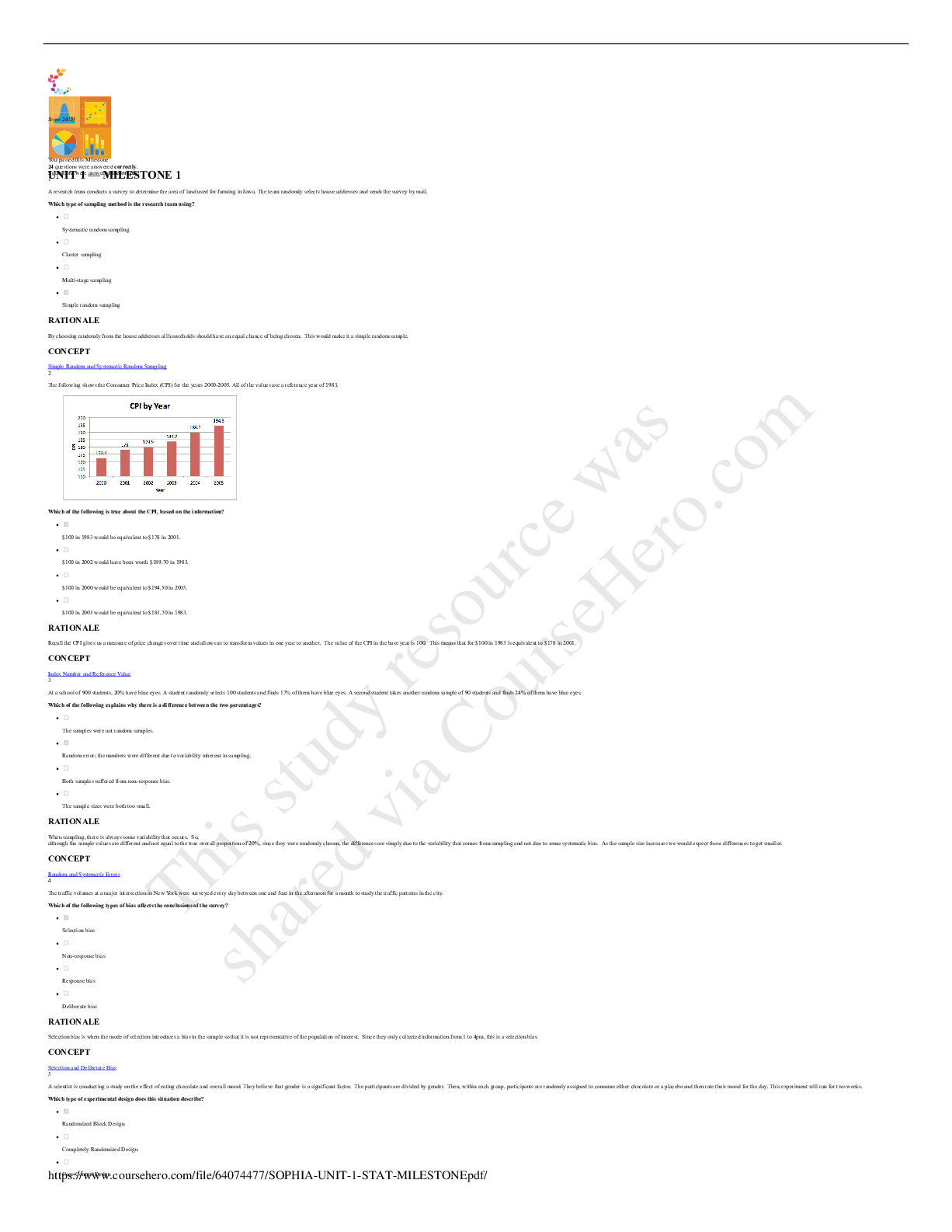

 – University of Maryland.png)
 – University of the People.png)
 – University of the People.png)
 – University of the People.png)
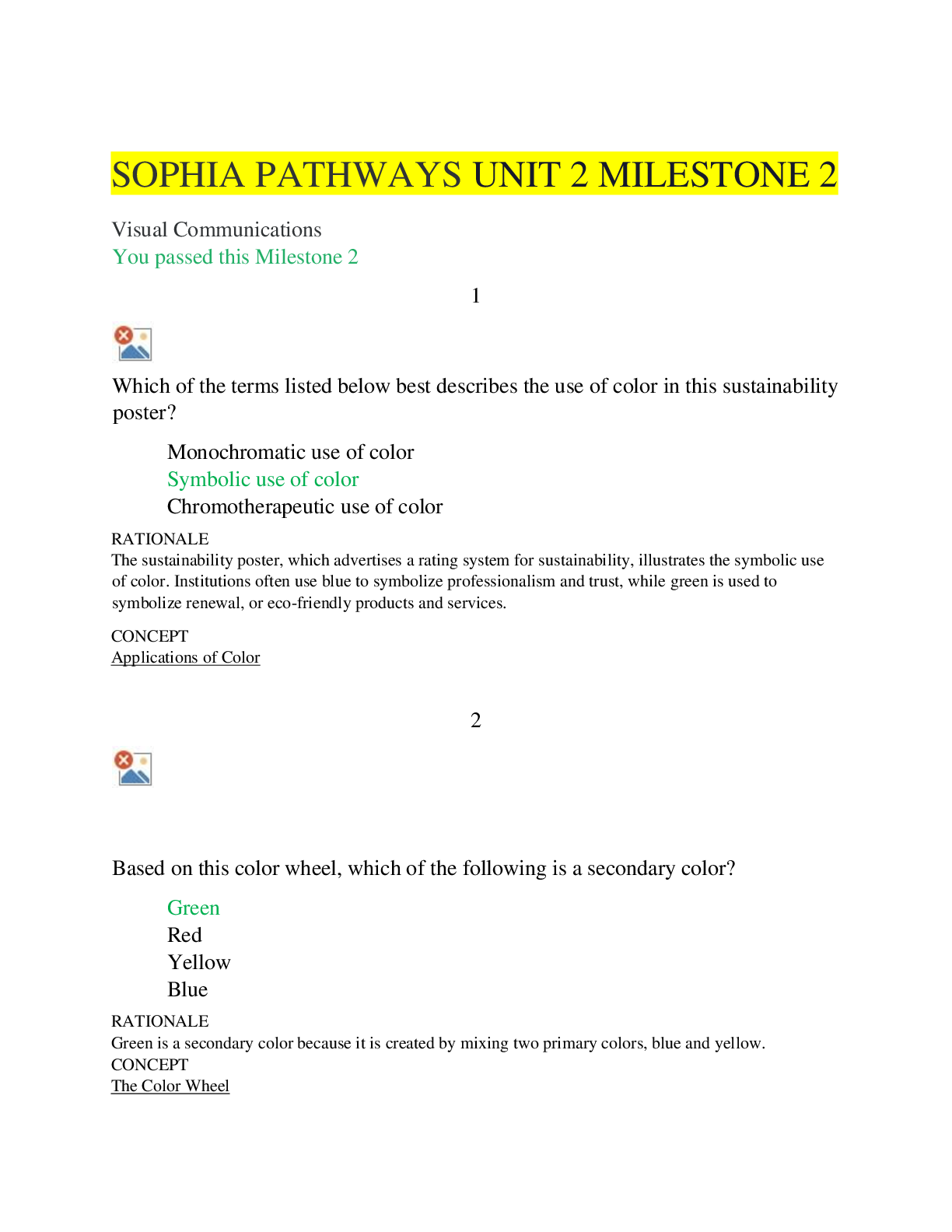
 – University of the People.png)
 – University of the people.png)
